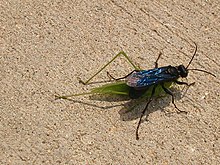Sphex pensylvanicus
| Sphex pensylvanicus | |
|---|---|

| |
| Scientific classification | |
| Domain: | Eukaryota |
| Kingdom: | Animalia |
| Phylum: | Arthropoda |
| Class: | Insecta |
| Order: | Hymenoptera |
| Family: | Sphecidae |
| Genus: | Sphex |
| Species: | S. pensylvanicus
|
| Binomial name | |
| Sphex pensylvanicus | |
| Synonyms[1][2] | |
| |
Sphex pensylvanicus, the great black wasp, is a species of digger wasp.[3] It lives across most of North America and grows to a size of 20–35 mm (0.8–1.4 in). The larvae feed on living insects that the females paralyze and carry to the underground nest.
Distribution[edit]
S. pensylvanicus is distributed across most of the contiguous United States and northern Mexico.[3] During the late 20th century, its range expanded north to New York[4] and the Canadian provinces of Quebec and Ontario.[5]
Description[edit]
Sphex pensylvanicus is a large, black wasp, significantly larger than their congener Sphex ichneumoneus (the great golden digger wasp).[6] Males are smaller than females, at only 19–28 mm (0.7–1.1 in) long compared with typical female sizes of 25–34 mm (1.0–1.3 in).[2] According to John Bartram, "The sting of this Wasp is painful, but does not swell like others".[7] As well as being larger than S. ichneumoneus, they are also darker, with smoky wings and an entirely black body, where S. ichneumoneus has yellow wings, red legs, and a partly red abdomen.[8]
Ecology and life cycle[edit]

Adult females of S. pensylvanicus build an underground nest which they provision with various orthopteran insects,[9] particularly of the genera Microcentrum, Amblycorypha and Scudderia.[6] Prey are stung three times, once in the neck and twice in the thorax, and are paralyzed by the wasp's sting, although they can survive for weeks.[2] The prey are then carried to the nest. While collecting their prey, the females are vulnerable to kleptoparasitism, in which birds, including the house sparrow (Passer domesticus) and the grey catbird (Dumetella carolinensis), steal the prey that the wasp has collected.[9]
The eggs of S. pensylvanicus are 5–6 mm (0.20–0.24 in) long and 1 mm (0.04 in) wide; they are glued to the underside of the prey insect between the first and second pairs of legs.[2] Each of the several chambers in the nest houses a single larva, which consumes 2–6 katydids or grasshoppers.[9] The larval stage lasts 10 days, reaching a pre-pupation size of 30–35 mm (1.2–1.4 in) long by 7–10 mm (0.28–0.39 in) wide.[2]
S. pensylvanicus is an important pollinator of plants including the milkweeds Asclepias syriaca and A. incarnata.[10] It has also been reported on Daucus carota, Eryngium yuccifolium, Melilotus albus,[11] Monarda punctata , and Pycnanthemum virginianum[12] S. pensylvanicus is one of several species of Sphex to be parasitized by the strepsipteran Paraxenos westwoodi.[13]
Taxonomic history[edit]
Sphex pensylvanicus was the subject of the first article on an insect written by a native of the New World,[2][14] when observations made by John Bartram on S. pensylvanicus were presented to the Royal Society in 1749 by Peter Collinson.[7] Sphex pensylvanicus was described by Carl Linnaeus in his 1763 work Centuria Insectorum, using material sent to him by Charles De Geer.[15]
References[edit]
- ^ Pulawski, Wojciech J. (27 May 2022). "Sphex" (PDF). Catalog of Sphecidae sensu lato. California Academy of Sciences. pp. 55–57. Retrieved 23 July 2022.
- ^ a b c d e f Frisch, John H. (1938). "The life-history and habits of the digger-wasp Ammobia pennsylvanica (Linn.)". American Midland Naturalist. 19 (3): 673–677. doi:10.2307/2420481. JSTOR 2420481.
- ^ a b Bohart, Richard Mitchell & Menke, Arnold S. (1976). Sphecid Wasps of the World: A Generic Revision. University of California Press. ISBN 978-0-520-02318-5.
- ^ Kurczewski, , Frank E. (1997). "Activity Patterns in a Nesting Aggregation of Sphex pensylvanicus L. (Hymenoptera: Sphecidae)". Journal of Hymenoptera Research. 6 (2): 231–242. Retrieved 2022-07-23.
{{cite journal}}: CS1 maint: multiple names: authors list (link) - ^ Lewis, Jake H. (2020). "Sphex ichneumoneus and Sphex pensylvanicus (Hymenoptera: Sphecidae) in Atlantic Canada: evidence of recent range expansion into the region". Canadian Field-Naturalist. 134 (1): 52–55. doi:10.22621/cfn.v134i1.2413.
- ^ a b Brockmann, H. Jane (1985). "Provisioning behavior of the great golden digger wasp, Sphex ichneumoneus (L.) (Sphecidae)". Journal of the Kansas Entomological Society. 58 (4): 631–655. JSTOR 25084707.
- ^ a b Collinson, Peter (December 21, 1749). "A Description of the Great Black Wasp, from Pensylvania[sic], as communicated from Mr. John Bartam to Mr. Peter Collinson, F. R. S." Philosophical Transactions of the Royal Society. 46 (491–496): 278–279. doi:10.1098/rstl.1749.0050. JSTOR 104640.
- ^ Arnett, Ross H. (2000). "Tribe Sphecini". American Insects: A Handbook of the Insects of America North of Mexico (2nd ed.). CRC Press. p. 595. ISBN 978-0-8493-0212-1.
- ^ a b c Benttinen, Justin & Preisser, Evan (2009). "Avian kleptoparasitism of the digger wasp Sphex pensylvanicus" (PDF). Canadian Entomologist. 141 (6): 604–608. doi:10.4039/n09-033.
- ^ Farnsworth, Elizabeth J. & DiGregorio, Mario J. (December 2001). "Conservation and Research Plan: Asclepias purpurascens L., purple milkweed" (PDF). New England Wild Flower Society.
- ^ O'Brien, Mark F. (August 31, 2006). "Sphex pensylvanicus". The Sphecid Wasps of Michigan (Hymenoptera: Sphecidae: Sphecinae). University of Michigan. Retrieved June 22, 2010.
- ^ Wilhelm, Gerould; Rericha, Laura (2017). Flora of the Chicago Region: A Floristic and Ecological Synthesis. Indiana Academy of Sciences. p. 905.
- ^ Miller, Richard S.; Pearce, April M. & O'Neill, Kevin M. (2009). "Prevalence of stylopization of Sphex ichneumoneus (L.) (Hymenoptera: Sphecidae) by Paraxenos westwoodi (Templeton) (Strepsiptera: Xenidae)". Psyche. 2009: 4 pp. doi:10.1155/2009/690125.
- ^ Stroud, Patricia Tyson (1995). "Forerunner of American conservation: naturalist Thomas Say". Forest & Conservation History. 39 (4): 184–190. doi:10.2307/3983959. JSTOR 3983959.
- ^ Day, M. C. (1979). "The species of Hymenoptera described by Linnaeus in the genera Sphex, Chrysis, Vespa, Apis and Mutilla". Biological Journal of the Linnean Society. 12 (1): 45–84. doi:10.1111/j.1095-8312.1979.tb00049.x.
External links[edit]
 Media related to Sphex pensylvanicus at Wikimedia Commons
Media related to Sphex pensylvanicus at Wikimedia Commons
